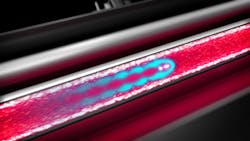New SLAC facility to focus on colliders and high-power light sources
The U.S. Department of Energy's SLAC National Accelerator Laboratory (Menlo Park, CA) has started to assemble a new facility for revolutionary accelerator technologies that could make future accelerators 100 to 1,000 times smaller and boost their capabilities. The project is an upgrade to the Facility for Advanced Accelerator Experimental Tests (FACET), a DOE Office of Science user facility that operated from 2011 to 2016. FACET-II (https://facet.slac.stanford.edu/) will produce beams of highly energetic electrons like its predecessor, but with even better quality. These beams will primarily be used to develop plasma acceleration techniques, which could lead to next-generation particle colliders that enhance our understanding of nature's fundamental particles and forces and novel X-ray lasers that provide us with unparalleled views of ultrafast processes in the atomic world around us.
RELATED ARTICLE: Ultrastable lasers from Northrop Grumman improve SLAC laser output
The DOE has now approved the $26 million project (Critical Decisions 2 and 3). The new facility, which is expected to be completed by the end of 2019, will also operate as an Office of Science user facility – a federally sponsored research facility for advanced accelerator research available on a competitive, peer-reviewed basis to scientists from around the world.
In conventional accelerators, particles draw energy from a radiofrequency field inside metal structures. However, these structures can only support a limited energy gain per distance before breaking down; therefore, accelerators that generate very high energies become very long and very expensive. The plasma wakefield approach promises to break new ground. Future plasma accelerators could, for example, unfold the same acceleration power as SLAC's historic 2-mile-long copper accelerator (linac) in just a few meters.
Researchers will use FACET-II for crucial developments before plasma accelerators can become a reality. "We need to show that we're able to preserve the quality of the beam as it passes through plasma," said SLAC's Mark Hogan, FACET-II project scientist. "High-quality beams are an absolute requirement for future applications in particle and X-ray laser physics."
Another important objective is the development of novel electron sources that could lead to next-generation light sources, such as brighter-than-ever X-ray lasers. These powerful discovery machines provide scientists with unprecedented views of the ever-changing atomic world and open up new avenues for research in chemistry, biology and materials science.
FACET-II has issued its first call for proposals for experiments that will run when the facility goes online in 2020.
SOURCE: SLAC; https://www6.slac.stanford.edu/news/2018-06-11-work-begins-new-slac-facility-revolutionary-accelerator-science.aspx

Gail Overton | Senior Editor (2004-2020)
Gail has more than 30 years of engineering, marketing, product management, and editorial experience in the photonics and optical communications industry. Before joining the staff at Laser Focus World in 2004, she held many product management and product marketing roles in the fiber-optics industry, most notably at Hughes (El Segundo, CA), GTE Labs (Waltham, MA), Corning (Corning, NY), Photon Kinetics (Beaverton, OR), and Newport Corporation (Irvine, CA). During her marketing career, Gail published articles in WDM Solutions and Sensors magazine and traveled internationally to conduct product and sales training. Gail received her BS degree in physics, with an emphasis in optics, from San Diego State University in San Diego, CA in May 1986.
